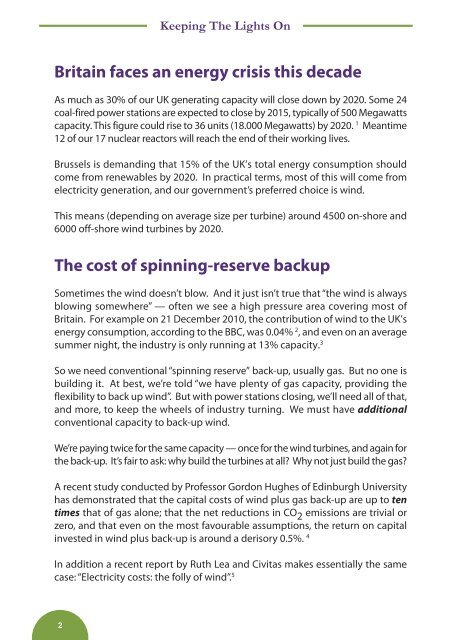keeping-the-lights-on
keeping-the-lights-on
keeping-the-lights-on
You also want an ePaper? Increase the reach of your titles
YUMPU automatically turns print PDFs into web optimized ePapers that Google loves.
Britain faces an energy crisis this decade<br />
As much as 30% of our UK generating capacity will close down by 2020. Some 24<br />
coal-fired power stati<strong>on</strong>s are expected to close by 2015, typically of 500 Megawatts<br />
capacity. This figure could rise to 36 units (18.000 Megawatts) by 2020. 1 Meantime<br />
12 of our 17 nuclear reactors will reach <str<strong>on</strong>g>the</str<strong>on</strong>g> end of <str<strong>on</strong>g>the</str<strong>on</strong>g>ir working lives.<br />
Brussels is demanding that 15% of <str<strong>on</strong>g>the</str<strong>on</strong>g> UK’s total energy c<strong>on</strong>sumpti<strong>on</strong> should<br />
come from renewables by 2020. In practical terms, most of this will come from<br />
electricity generati<strong>on</strong>, and our government’s preferred choice is wind.<br />
This means (depending <strong>on</strong> average size per turbine) around 4500 <strong>on</strong>-shore and<br />
6000 off-shore wind turbines by 2020.<br />
The cost of spinning-reserve backup<br />
Sometimes <str<strong>on</strong>g>the</str<strong>on</strong>g> wind doesn’t blow. And it just isn’t true that “<str<strong>on</strong>g>the</str<strong>on</strong>g> wind is always<br />
blowing somewhere” — often we see a high pressure area covering most of<br />
Britain. For example <strong>on</strong> 21 December 2010, <str<strong>on</strong>g>the</str<strong>on</strong>g> c<strong>on</strong>tributi<strong>on</strong> of wind to <str<strong>on</strong>g>the</str<strong>on</strong>g> UK’s<br />
energy c<strong>on</strong>sumpti<strong>on</strong>, according to <str<strong>on</strong>g>the</str<strong>on</strong>g> BBC, was 0.04% 2 , and even <strong>on</strong> an average<br />
summer night, <str<strong>on</strong>g>the</str<strong>on</strong>g> industry is <strong>on</strong>ly running at 13% capacity. 3<br />
So we need c<strong>on</strong>venti<strong>on</strong>al “spinning reserve” back-up, usually gas. But no <strong>on</strong>e is<br />
building it. At best, we’re told “we have plenty of gas capacity, providing <str<strong>on</strong>g>the</str<strong>on</strong>g><br />
flexibility to back up wind”. But with power stati<strong>on</strong>s closing, we’ll need all of that,<br />
and more, to keep <str<strong>on</strong>g>the</str<strong>on</strong>g> wheels of industry turning. We must have additi<strong>on</strong>al<br />
c<strong>on</strong>venti<strong>on</strong>al capacity to back-up wind.<br />
We’re paying twice for <str<strong>on</strong>g>the</str<strong>on</strong>g> same capacity — <strong>on</strong>ce for <str<strong>on</strong>g>the</str<strong>on</strong>g> wind turbines, and again for<br />
<str<strong>on</strong>g>the</str<strong>on</strong>g> back-up. It’s fair to ask: why build <str<strong>on</strong>g>the</str<strong>on</strong>g> turbines at all? Why not just build <str<strong>on</strong>g>the</str<strong>on</strong>g> gas?<br />
A recent study c<strong>on</strong>ducted by Professor Gord<strong>on</strong> Hughes of Edinburgh University<br />
has dem<strong>on</strong>strated that <str<strong>on</strong>g>the</str<strong>on</strong>g> capital costs of wind plus gas back-up are up to ten<br />
times that of gas al<strong>on</strong>e; that <str<strong>on</strong>g>the</str<strong>on</strong>g> net reducti<strong>on</strong>s in CO 2 emissi<strong>on</strong>s are trivial or<br />
zero, and that even <strong>on</strong> <str<strong>on</strong>g>the</str<strong>on</strong>g> most favourable assumpti<strong>on</strong>s, <str<strong>on</strong>g>the</str<strong>on</strong>g> return <strong>on</strong> capital<br />
invested in wind plus back-up is around a derisory 0.5%. 4<br />
In additi<strong>on</strong> a recent report by Ruth Lea and Civitas makes essentially <str<strong>on</strong>g>the</str<strong>on</strong>g> same<br />
case: “Electricity costs: <str<strong>on</strong>g>the</str<strong>on</strong>g> folly of wind”. 5<br />
2<br />
Keeping The Lights On


